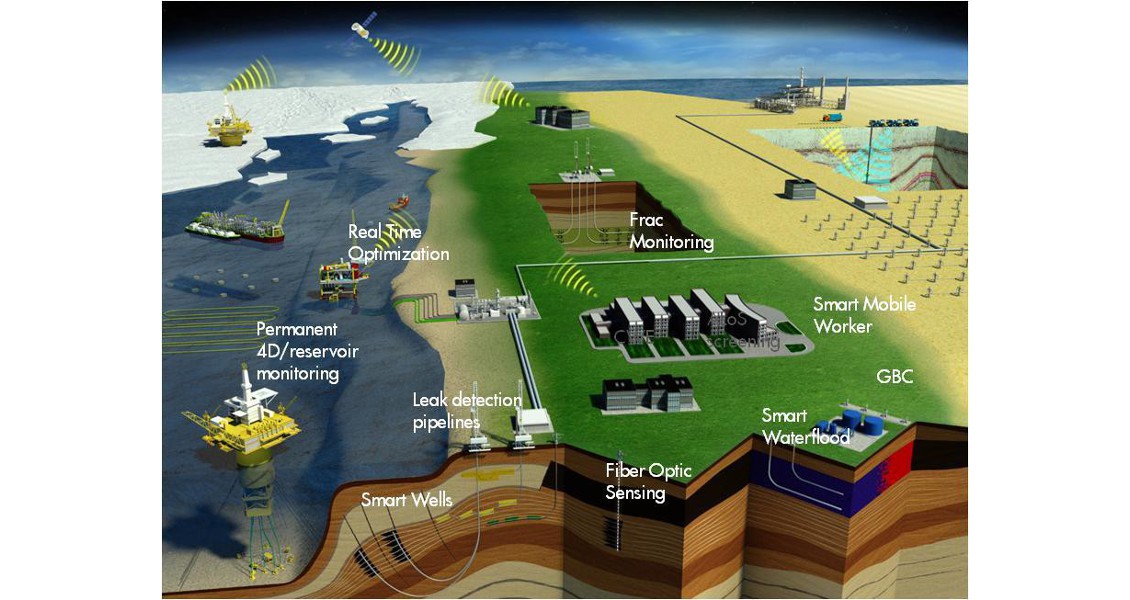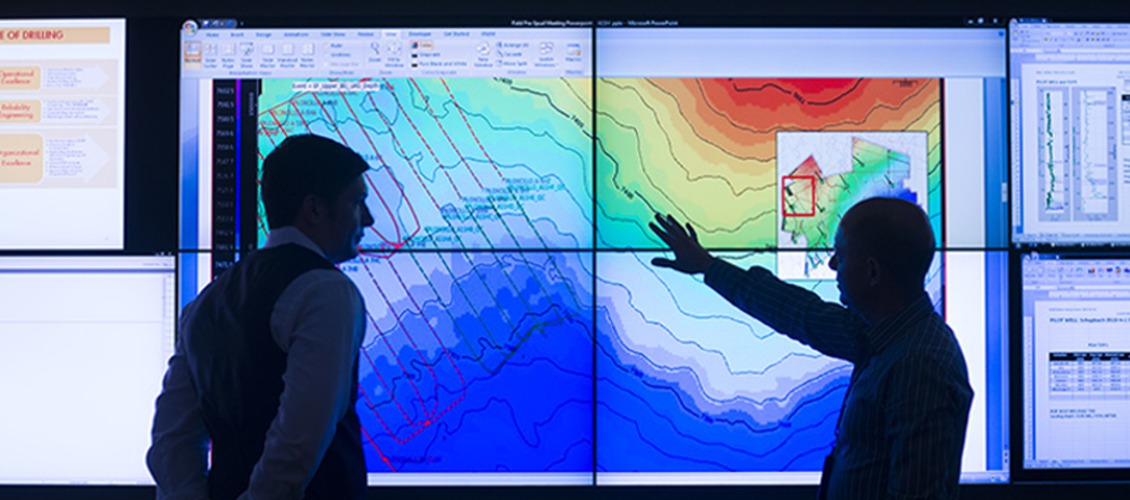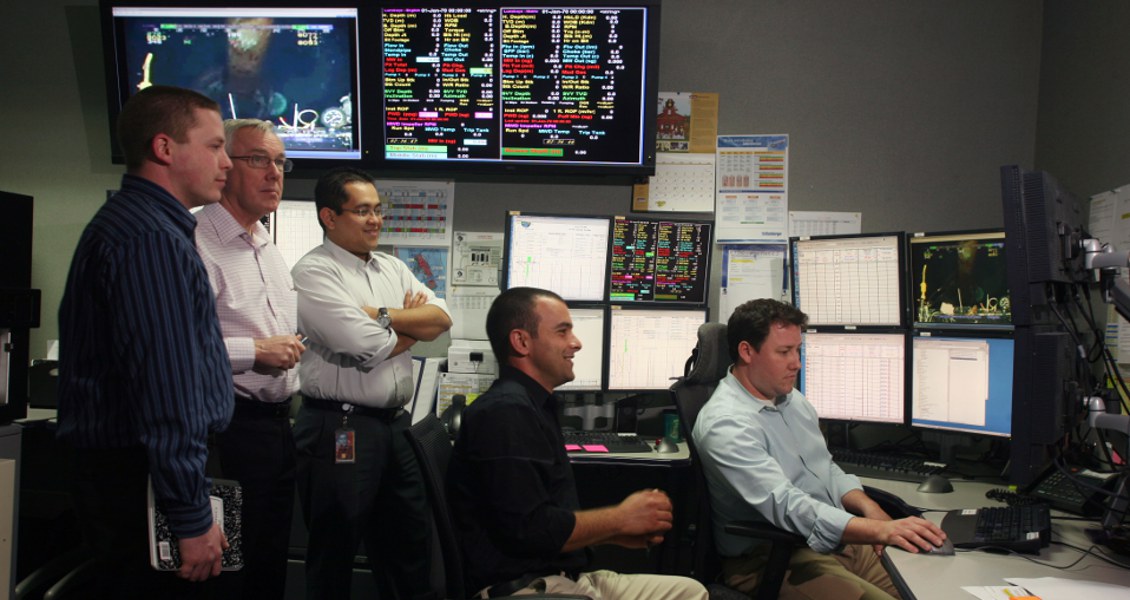Intelligent digital oil or gas fields – known as ‘Smart Fields’ to Shell employees – are asset or groups of assets that can be optimized continuously. This is achieved via integrated models and workflows which can manage both surface and subsurface aspects of the field to maximize lifecycle value, while honoring existing operational constraints. For more than a decade, Shell’s Smart Fields program has built intelligent capabilities into key field developments by introducing new technologies and ways of working to ensure that there are appropriate technical solutions for each asset to become technology-enabled from the earliest phase in its development: in essence, the innovative integration of people, processes and technology.
The main areas in which Smart Field workflows and technologies are applied are production surveillance and optimization, smart wells, real time monitoring and optimization, and time lapse reservoir surveillance. Assets which are part of the Smart Fields program have shown increased production, timely delivery, faster and superior decision-making, improved cooperation and increased ultimate recovery, while reducing costs and HSSE exposure.
Integration and Collaboration
Shell’s focus is on integrated solution generation through Appropriate Level of Smartness (ALoS) methodology, ensuring that the project is ‘Born Smart’. Firstly, ALoS screening identifies which solutions to include in order to maximize the project value and help reduce its key business uncertainties, looking at the whole lifecycle. Secondly, ALoS deployment focuses on having the ALoS Recommended Solutions at start-up, and then using them in a sustainable way going forward, tracking progress and mobilizing support to provide a consolidated overview and to help set focus and targeting actions in a meaningful way.
There are many Smart Fields solutions and they may be applicable for many types of fields – but not every solution works everywhere.
For example, the implementation of Collaborative Work Environments (CWEs), which bring together petroleum engineers, well services and offshore operations staff in virtual real-time decision-making, has proved key to the success of the Smart Fields initiative. The concept of CWEs has evolved, gradually expanding from real time monitoring centers to the development of standard solutions and designs for the various processes and disciplines involved.
CWEs have become standard practice and have been implemented on a large scale, most focusing on the production and field surveillance area and on real time monitoring, improving cooperation across disciplines and between office and field locations, thus enabling enhanced decision-making. Strong focus has been placed on embedding these new ways of working in the organization, based on the philosophy of how a field should be managed, so each operation is based on one data set, one plan and one common set of priorities. It is a flexible and multilateral instrument that integrates people, processes and technology so that, for each asset, an assessment identifies the key aspects relevant to the asset and formulates the best collaborative solution for it.
Shell estimates that CWEs contribute to production gains of between 1% and 5%, creating considerable value to the assets. In addition, they result in reduced travel, lower HSSE exposure and higher staff morale, better common understanding of the field, faster response to observed and predicted events in wells and facilities and improved activity planning.
Benefits of Smart Fields
A decade of experience in applying Smart Fields applications around the globe has shown that significant value can be derived if we gather more information from reservoirs, wells and facilities. In fact, Shell has demonstrated that over a five-year period the value of Smart Fields implementation to the company was in the region of US$5 billion (Van den Berg et al., 2010).
About 200 smart wells have already been deployed by Shell, resulting in significant impact to the business; the estimated value of these alone is more than US$3 billion. In Siberia, the use of Smart Field technology has resulted in the ESP start-up time after trips being reduced by more than 50%, which has also avoided additional travel in sub -40°C temperatures. Similarly, using 4D seismic in Europe has led to the drilling of wells in previously by-passed oil-bearing areas and avoided drilling in watered-out zones, while in the US the use of land microseismic gave rise to a modified injection strategy, adding significantly more reserves.
Installing Smart Fields remote monitoring and operation capabilities in a Middle East asset resulted in 20% less travel time to and from wells and to the mothballing of some gas compressors due to higher production and less flaring, while smart wells helped unlock several hundred million barrels of oil in the Asian offshore environment.
Sustaining Solutions and Benefits
Having proved the effectiveness of Smart Fields solutions, it is important to show they can be sustained, and continue to be used, after the implementation project has finished. This has sometimes been difficult to achieve, particularly if, for example, the original sponsor is moved to a new job after the initial project team has left, and all relevant project staff in the asset team are replaced. To achieve the desired sustainability of the solutions and benefits, specific elements need to be in place during the design and implementation phases.
The existing implementations of Smart Fields technologies have provided a wealth of information to suggest which elements were likely to result in a successful roll-out and what was required for sustainability. To understand the key drivers and pitfalls in global implementation, a ‘sustain’ methodology was developed which provided insight into where these areas were, and which has led to a significant change in Shell’s approach to the preparation for deployment of smart technologies.
Since integration is usually a critical proponent of smart technologies, more emphasis was placed on designing capability, creating a ‘value loop’ (measure – model – decide – execute) with defined workflows and staff roles. It was realized that a number of requirements need to be in place during integration.
Critical success factors for sustainability of the solutions were identified as:
- Implementation of technology wrapped as integrated capability, with the focus on people and organizational elements;
- Fitting the technologies in a closed loop results in solutions that fit in the asset setup;
- Business ownership of the full solution, including after the implementation;
- Alignment of the solutions with business needs;
- Quality of the project team leaders during implementation;
- Clear accountability for data quality assurance;
- A support structure to help staff, covering processes software, instruments, infrastructure and data;
- Local and global learning and sharing of the practitioners;
- Key performance indicators to ensure workflow and people elements are maintained and in place.
Transformational Leaders Needed
There are five important elements in the successful deployment of Smart Fields: leadership, organizational structure, people, behavior, and process and technology. Smart Fields implementation in particular requires tailored talent management: the right number of people, with the right knowledge and skills, in the right location. People with problem-solving skills and the ability to grasp new ideas make competent Smart Fields professionals, preferably also with resilience, good communication abilities in a multidisciplinary environment, multidisciplinary business knowledge, marketing skills to help ‘sell’ the vision or solution, and transformational leadership to inspire people with a shared vision of the future with clear goal setting. A tall order!
Learning from successes and failures in the implementation of Smart Fields has given, and continues to give, deep insights in optimizing the approach for technology deployment. In future, today’s ‘nice-to-have’ technology will increasing become a standard to enhance an asset’s value.








